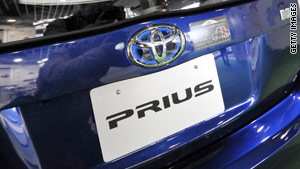First there was that quirky little problem when it transitioned from battery to engine.
Then there was the brake pedal traveling to the floor and warning lights coming on.
Because there were NO computer errors codes, the dealer and Toyota pronounced the car in working order.
Would you drive a vehicle with unpredictable computer performance?
Would you risk your life, that of your family and innocent strangers on Toyota's failure to correct its software problems?
Let's get beyond the superficial and consider owners who have put mileage on this Toyota lemon.
I may be the first to complain about this. Rest assured, this is just the beginning of another failure of Toyota to correct its problems.
How many more families will they kill before they correct the problem?
May 18, 2012,
Reviewing the Toyota Prius C
By THE NEW YORK TIMES
Nick Czap for The New York Times2012 Toyota Prius C.
In Sunday’s Automobiles section, Nick Czap reviews the 2012 Toyota Prius C, a lightweight hybrid hatchback that, in its first three days of availability, surpassed the February sales of both the Chevrolet Volt and Nissan Leaf.
As Mr. Czap writes, the Prius C is a charmer, especially in relation to the indifferently styled Prius Liftback:
Where the Prius Liftback is all monolithic planar mass, the Prius C is all curves and flares and bulges. And while the Liftback’s top-heavy look suggests a predilection for straight-line travel, the C’s wide, low-slung, wheels-to-the-corners stance hints at a penchant for playing.The Prius C wields a substantial fuel-economy advantage over similarly sized hatchbacks like the Honda Fit and the Ford Fiesta, which, given the hybrid’s sub-$20,000 price, should worry competitors, Mr. Czap concludes.
Read the entire review, check out the slide show and share your thoughts on the Prius C in the comments.
http://wheels.blogs.nytimes.com/2012/05/18/reviewing-the-toyota-prius-c/
USDOT Proposes Updated Safety Standard to Prioritize Braking Control, Reduce Risk of High-Speed Unintended Acceleration for Nation's Cars
April 12, 2012
Contact: Karen Aldana, 202-366-9550
'Brake-Throttle Override' requirement will reduce the risk of high-speed unintended acceleration involving a stuck or trapped accelerator pedal
WASHINGTON – The U.S. Department of Transportation's National Highway Traffic Safety Administration (NHTSA) today proposed to update existing safety standards to ensure drivers can better stop a vehicle in the event both the brake and accelerator pedals are depressed at the same time. NHTSA research indicates a "Brake-Throttle Override" requirement will help reduce the risks of high-speed unintended acceleration and prevent crashes involving a stuck or trapped accelerator pedal by allowing the driver to maintain control through normal application of the vehicle's brakes.
"America's drivers should feel confident that anytime they get behind the wheel they can easily maintain control of their vehicles — especially in the event of an emergency," said U.S.
Transportation Secretary Ray LaHood. "By updating our safety standards, we're helping give drivers peace of mind that their brakes will work even if the gas pedal is stuck down while the driver is trying to brake."
The NHTSA proposal aims to minimize the risk that drivers will lose control of their vehicles as a result of either accelerator control system disconnections or accelerator pedal sticking or floormat entrapment. The proposal would amend Federal Motor Vehicle Safety Standard (FMVSS) No. 124, Accelerator Control Systems, by updating the throttle control disconnection test procedures for all passenger cars, multipurpose passenger vehicles, trucks and buses, regardless of weight. For vehicles that have Electronic Throttle Control (ETC) and a gross vehicle weight rating (GVWR) 10,000 lbs. (4,536 kilograms) or less, the proposal would also require manufacturers include a Brake-Throttle Override (BTO) system to ensure the vehicle would stop if both the brake and the accelerator pedals are simultaneously applied. Many manufacturers are already including BTO systems in their vehicle fleets.
"We learned as part of the comprehensive NASA and NHTSA studies of high-speed unintended acceleration that brake override systems could help drivers avoid crashes," said NHTSA
Administrator David Strickland. "While NHTSA's defect investigation program will continue to monitor and consider consumer complaints of any potential vehicle safety issues, this proposal is one way the agency is helping keep drivers safe and continuing to work to reduce the risk of injury from sticky pedals or pedal entrapment issues."
Members of the public are encouraged to provide comment on NHTSA's "Brake-Throttle Override" proposal and will have 60 days to do so once the proposal is published in the Federal Register. View the proposal
For additional information on NASA and NHTSA's studies of high-speed unintended acceleration, visit www.nhtsa.gov/UA.
http://www.nhtsa.gov/About+NHTSA/Press+Releases/2012/USDOT+Proposes+Updated+Safety+Standard+to+Prioritize+Braking+Control,+Reduce+Risk+of+High-Speed+Unintended+Acceleration+for+Nation%27s+Cars
Toyota Recall – How long will we have to wait? http://aviscogitations.wordpress.com/2010/01/28/toyota-recall-how-long-will-we-have-to-wait/
New details in crash that prompted Toyota recall
A federal report finds a possible flaw in the gas pedal design of a runaway Lexus that crashed in August, killing CHP Officer Mark Saylor and three family members and leading to a massive recall.
"I love Toyotas but I will not drive a Prius again."
Toyota dealerships were flooded with calls after the company admitted problems with their Prius model's anti-lock brakes system. Dean Reynolds reports.
Driver Finds Accelerator Problem On Prius
http://www.youtube.com/watch?v=F9KRk7E6G-U&feature=fvwrel
Toyota Prius drivers await whether the company is planning a recall that could involve 37,000 hybrids in the U.S. There are also reports that used Toyotas are losing their value. Celia Hatton reports. A Lenexa man is wondering if he's found another accelerator problem on his new Toyota Prius. KMBC's Micheal Mahoney reports.
Last month, Toyota issued a massive recall of nearly 4 million Toyota and Lexis vehicles. The recall is intended to fix a very dangerous defect which can lead to Unintended Acceleration of the vehicle. Initially thought to be an issue with floor mats, the real problem involves the cars electronic throttle system. The recall was prompted by a high speed crash in August in California of a Lexus barreling out of control. As the vehicle hit speeds exceeding 120 mph, family members made a frantic 911 call and said the accelerator was stuck and they couldnt stop the vehicle.
California highway patrol officer and three family members were killed when their loaner car's accelerator stuck and they crashed going 100 mph. The audio of the 911 call made from the car moments before the crash has just been released.
"This may be the day I die."
"...a glitch of some kind...."
Beasley Allen attorney, Graham Esdale discusses a lawsuit filed by the families of Jean Bookout and Barbara Schwarz of Yukon, Oklahoma. Toyota is accused of 'negligence, failure to warn, breech of warranty and deceit.'
NO COMPUTER ERROR CODE!
A new investigative report, complete with an automotive professor from a major college, claims to show proof of an inherent design flaw with Toyotas electronics that can cause a vehicle to experience unintended sudden acceleration. The automotive professor went as far as to demonstrate the occurrence with the reporter driving and cameras rolling.
Brian Ross of ABC News has tracked down a college professor, Dave Gilbert, from Southern Illinois University, in order to investigate Gilberts claim that the electronics could possibly be to blame for the cases of sudden acceleration in modern Toyota vehicles.
According to automotive professor Gilbert, there is a flaw in Toyotas design that allows particular short circuits that could be caused by corrosion, moisture or manufacturing imperfections. In order to recreate the issues for ABC News, however, Gilbert utilized an external bypass system that he says will recreate conditions otherwise possible without any outside devices.
The system is fallible, in fact, its got some really troubling design strategies that are employed by Toyota that appear to be outside the norm [of the auto industry]. And their system clearly has a design strategy that has a very slim margin of safety, said Sean Kane, safety advocate from Safety Research and Strategies. Kane was responsible for first spotting the pattern of so-called runaway Toyotas from NHTSA complaints.
Gilbert first contacted senior Toyota engineers in California about these claims last week, and says they were surprised at his claim. Toyota at first believed that what Gilbert described would not produce any unintended acceleration. Toyota also clarified that if a short ever were to occur, the dashboard would light up and indicate an issue contrary to Gilberts findings in which no dash lights were illuminated, and no DTC error codes were produced.
Gilbert has so far been able to replicate the short-induced unintended sudden acceleration on a Lexus, Toyota Tundra, Avalon and on a Matrix.
This is a dangerous condition, it is not fail safe, said Gilbert.
Gilbert also went on to explain that he has attempted to recreate the same short with vehicles made by other manufacturers as well, as a basis for comparison, and found that other makes did not experience the unintended sudden acceleration.
Other vehicle manufacturers have gone to great extremes [to prevent the problem he found on Toyotas], he said. His tests on GM cars did not find a similar flaw, he said, not even close.
Toyota has since released an official press release following the ABC News investigation, saying that based on the footage seen on ABC News, Toyota believes what Gilbert displayed is different than they first understood. Toyota has invited both Professor Gilbert and ABC News to bring the Avalon in question to Toyota for further testing.
Toyota welcomes the opportunity to evaluate the Toyota Avalon shown in todays story and the method by which Mr. Gilbert allegedly caused the vehicle to accelerate unintentionally. We welcome the attendance of ABC News at any such evaluation of this vehicle and Mr. Gilberts testing, Toyota announced in a press release.
Both Professor Gilbert and Sean Kane are scheduled to speak in front of the House committee on Tuesday, February 23, 2010.
Toyota: Software to blame for Prius brake problems
Without issuing a recall of its iconic Prius hybrid vehicles, Toyota said Thursday a software glitch is to blame for braking problems in the 2010 model.
"We would want to be given a little time," Hiro Yuki Yokoyama, Toyota's managing officer, said when reporters asked whether a recall was in the works.
The company changed its braking system software in January as part of what it called "constant quality improvements," but did not say what it would do about vehicles manufactured before then.
http://articles.cnn.com/2010-02-04/world/japan.prius.complaints_1_brake-system-anti-lock-prius-hybrid?_s=PM:WORLD
"We would want to be given a little time," Hiro Yuki Yokoyama, Toyota's managing officer, said when reporters asked whether a recall was in the works.
The company changed its braking system software in January as part of what it called "constant quality improvements," but did not say what it would do about vehicles manufactured before then.
http://articles.cnn.com/2010-02-04/world/japan.prius.complaints_1_brake-system-anti-lock-prius-hybrid?_s=PM:WORLD
ABC News Alleges Toyota's Problem Isn't Pedals, and Isn't Fixed
Posted: Feb 23, 2010



 RSS this page
RSS this page 




 To: Mayor Thomas M. Menino, Boston City Councilors, Governor Deval Patrick and Legislators
To: Mayor Thomas M. Menino, Boston City Councilors, Governor Deval Patrick and Legislators